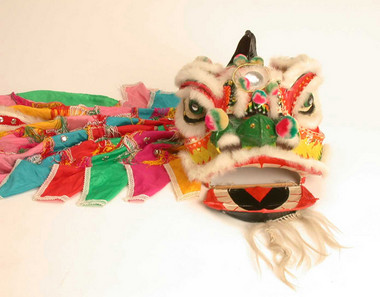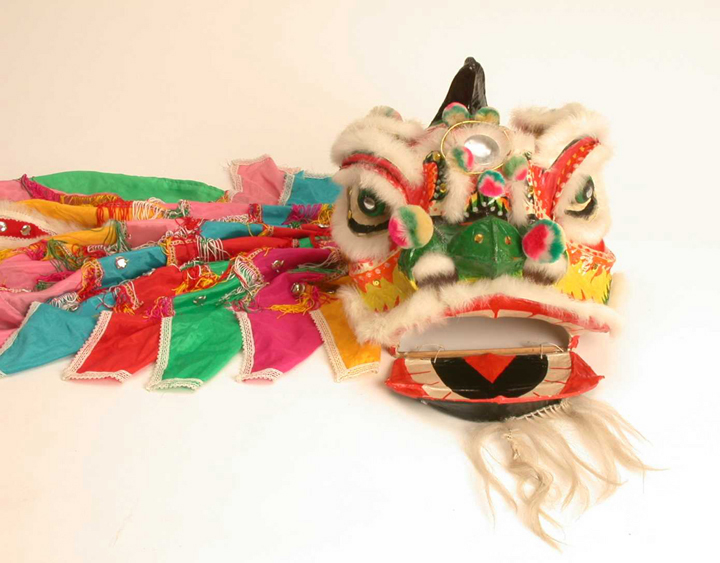Lion Mask, China
Lion Dancing is a traditional folk sport. Skilled acrobats, wearing masks, dance to make the 'lion' seem alive. The mask is used to celebrate Chinese New Year, bringing good luck to the places it visits.
It is in two parts - the head and the tail. The head is made of papier-maché on a wire frame and painted in vivid colours. Artificial fur and tinsel borders the lion's mouth, nostrils, eyes and the crown of the head. The mouth is open, showing the teeth. Its round, bulging eyes are wide apart. Soft baubles of fur that bounce around when the lion's head is moved are attached by wire to the nose and between the eyes. The long tail of the lion is made of silky material decorated with embroidered thread and tassels.
This mask is made for two performers. One person's head goes right inside the mask. The wearer grips the bar that runs across the back of the lion's mouth. Another person manipulates the tail and mirrors the head's movements. Together the two people choreograph their actions to make the lion appear to crouch and rear up as it cavorts and dances through the streets.
It is in two parts - the head and the tail. The head is made of papier-maché on a wire frame and painted in vivid colours. Artificial fur and tinsel borders the lion's mouth, nostrils, eyes and the crown of the head. The mouth is open, showing the teeth. Its round, bulging eyes are wide apart. Soft baubles of fur that bounce around when the lion's head is moved are attached by wire to the nose and between the eyes. The long tail of the lion is made of silky material decorated with embroidered thread and tassels.
This mask is made for two performers. One person's head goes right inside the mask. The wearer grips the bar that runs across the back of the lion's mouth. Another person manipulates the tail and mirrors the head's movements. Together the two people choreograph their actions to make the lion appear to crouch and rear up as it cavorts and dances through the streets.

Mask Head Width:30cm Train Length:125cm
Lions are supposed to bring good luck and be guardians against evil. Real lions are not found in China, and the mask's head looks rather like a Tibetan dog. The lion mask is worn to perform the Lion Dance, which takes place at celebrations such as weddings, the opening of a new business or moving to a new home. The Lion Dance is also performed at the beginning of the Chinese New Year celebrations to bring luck to houses in the community. Chinese people believe that these houses are then blessed, and protected from evil for the coming year.
The Chinese New Year celebrations take place over three days in late January or early February. People prepare for the festival by putting their finances in order and paying off debts so that they can start anew. They clean their houses and decorate their doors with red scrolls. These scrolls are written with texts asking for good luck for the coming year.
The Lion Dance is done in the street or a public place. Musicians accompany the lion so the lion dances to the rhythm of drums, gongs and cymbals. Firecrackers are sometimes let off. All the loud noise from the firecrackers and musical instruments serves to dispel evil and bring good luck. The lion visits houses and businesses. When it reaches a house it stops at the entrance to take an offering which has been tied above the door by the owners. The offering is a red packet tied up with string and green leaves. The lion pretends to eat the leaves, rolling on the floor to the sound of the drums. This is called ''Picking the Leaves'' (Choi Cheng). Then the lion leaps to its feet and spits out the leaves. This is an act of blessing by the lion and shows that the house or business will have an abundance of food and wealth in the New Year.
Two skilled ]acrobats perform the Lion Dance, one at the head and one at the end of the tail. The spectacular Dragon Dance, which may have up to thirty people in the dragon's tail, is also performed at celebrations and festivals, including the Chinese New Year.
The lion mask also appears in the Chinese Circus, where one of the major attractions is the Dancing Lions. In this case the lions have four legs rather than a tail. One performer is the lion's head and front legs, while another is the lion's body and back legs.
The Chinese New Year celebrations take place over three days in late January or early February. People prepare for the festival by putting their finances in order and paying off debts so that they can start anew. They clean their houses and decorate their doors with red scrolls. These scrolls are written with texts asking for good luck for the coming year.
The Lion Dance is done in the street or a public place. Musicians accompany the lion so the lion dances to the rhythm of drums, gongs and cymbals. Firecrackers are sometimes let off. All the loud noise from the firecrackers and musical instruments serves to dispel evil and bring good luck. The lion visits houses and businesses. When it reaches a house it stops at the entrance to take an offering which has been tied above the door by the owners. The offering is a red packet tied up with string and green leaves. The lion pretends to eat the leaves, rolling on the floor to the sound of the drums. This is called ''Picking the Leaves'' (Choi Cheng). Then the lion leaps to its feet and spits out the leaves. This is an act of blessing by the lion and shows that the house or business will have an abundance of food and wealth in the New Year.
Two skilled ]acrobats perform the Lion Dance, one at the head and one at the end of the tail. The spectacular Dragon Dance, which may have up to thirty people in the dragon's tail, is also performed at celebrations and festivals, including the Chinese New Year.
The lion mask also appears in the Chinese Circus, where one of the major attractions is the Dancing Lions. In this case the lions have four legs rather than a tail. One performer is the lion's head and front legs, while another is the lion's body and back legs.

Mask Head Width:30cm Train Length:125cm

Lion Dancing is a traditional folk sport. Skilled acrobats, wearing masks, dance to make the 'lion' seem alive. The mask is used to celebrate Chinese New Year, bringing good luck to the places it visits.
It is in two parts - the head and the tail. The head is made of papier-maché on a wire frame and painted in vivid colours. Artificial fur and tinsel borders the lion's mouth, nostrils, eyes and the crown of the head. The mouth is open, showing the teeth. Its round, bulging eyes are wide apart. Soft baubles of fur that bounce around when the lion's head is moved are attached by wire to the nose and between the eyes. The long tail of the lion is made of silky material decorated with embroidered thread and tassels.
This mask is made for two performers. One person's head goes right inside the mask. The wearer grips the bar that runs across the back of the lion's mouth. Another person manipulates the tail and mirrors the head's movements. Together the two people choreograph their actions to make the lion appear to crouch and rear up as it cavorts and dances through the streets.
It is in two parts - the head and the tail. The head is made of papier-maché on a wire frame and painted in vivid colours. Artificial fur and tinsel borders the lion's mouth, nostrils, eyes and the crown of the head. The mouth is open, showing the teeth. Its round, bulging eyes are wide apart. Soft baubles of fur that bounce around when the lion's head is moved are attached by wire to the nose and between the eyes. The long tail of the lion is made of silky material decorated with embroidered thread and tassels.
This mask is made for two performers. One person's head goes right inside the mask. The wearer grips the bar that runs across the back of the lion's mouth. Another person manipulates the tail and mirrors the head's movements. Together the two people choreograph their actions to make the lion appear to crouch and rear up as it cavorts and dances through the streets.
- Term:
- Description:
- Abundance
- A great amount.
- Acrobat
- An entertainer who performs gymnastic feats.
- Blessing
- A favour given by a holy person, spirit or god.
- Cavort
- To caper about, frisk, or move playfully.
- Chinese New Year
- The Chinese festival marking the end of Winter and the beginning of Spring.
- Choi cheng
- The Chinese name for the part in the Lion Dance where the lion pretends to pick the leaves.
- Dragon Dance
- A ceremonial dance performed by acrobats manipulating a dragon mask and tail. The dance takes place at Chinese festivals.
- Firecrackers
- Explosive fireworks; bangers.




















